USCENTCOM Afghan Good News
Just received a news release from the CENTCOM PAO with good news out of Afghanistan. Hat tip to SPC Flowers.
Good stuff. BTW, the French military guys (enlisted and lower officer that is) that I have worked with have always been pretty cool. Like most in the Warrior Caste, they typically have a different world-view.
FOR IMMEDIATE RELEASE
Aug. 27, 2005
Release # 050827-05
Training ignites first Afghan Army demining operation
By U.S. Army Capt. Cenethea Harraway
Office of Security Cooperation-Afghanistan Public Affairs
KABUL, Afghanistan — The Afghan National Army recently put their training to use as they successfully conducted the first ANA-led demining operation in Afghanistan . The mission highlighted not only the expanding military capabilities of the ANA, but the government’s commitment to achieve a mine-free Afghanistan for future generations.
With the approval of the Afghan Ministry of Defense, the ANA leadership took charge and organized two days of real-world demining operations at the Area Military Depot of Pol-e-Charkhi. HALO Trust, a British-based non-governmental organization dedicated to humanitarian mine clearing, identified the area as containing mines.
“Getting the soldiers to work in a real minefield immediately after training was essential to instill the courage and confidence needed to do their job,” said French Army Capt. Thierry Sagon, the primary instructor for demining training.
The demining operation consisted of three main areas: the entry control point, the demining zone and the company area of operations.
At the entry control point, each two-man demining buddy team received a safety briefing and protective gear. They were also listed on an accountability roster by name and blood type. Each buddy team was comprised of a first-degree and a second-degree deminer. A first-degree rating qualifies deminers to search for mines and provide initial detection. Second-degree deminers, who are also rated as instructors are qualified to identify and determine which neutralization method is best for disabling each mine or munition. The ANA company leadership provided the overall command and control for the operation.
Safety was emphasized over speed, with the operation occurring in a secured environment under daylight conditions. A medical evacuation team was on site as well. In the demining zone, three two-man buddy teams took positions 50 meters apart and worked in corridors 80 centimeters wide. Since manual demining can be tedious, repetitive and dangerous, the teams were rotated every 20 minutes as a safety precaution.
During the second day of the operation, the Afghan demining teams discovered an improvised explosive device and a Russian anti-personnel mine. Applying their knowledge and training, the deminers quickly assessed the situation and determined that the IED could be safely detonated in place. They marked the anti-personnel mine’s location and left it in place for later destruction.
The Afghan demining teams cheered and applauded their first live detonation. Yet their confidence and elation did not distract them from the gravity of their work. Only two months prior, 90 members of the engineer company from the 3rd Brigade, 201st Corps’ 4th Combat Support Kandak (Battalion) completed advanced demining training and earned their first and second-degree ratings.
Members of the French Army’s Engineer Mobile Training Team conducted the training as part of Operation Epidote, the name France has given to its entire training mission in Afghanistan.
“It was very necessary for the Afghan Army to be involved today and to show that they can learn and execute technical skills,” said Lt. Col. Gaetan Sevin, chief of the French training team. “We do not alter our standards of training. The Afghan soldiers are trained just as we are in France . We are very pleased with the outcome and have much confidence in the abilities of the soldiers.”
The 4th Kandak’s Engineer Company was the first ANA unit to complete the comprehensive two-month demining training. According to the French instructors, they trained in realistic, difficult situations to master the drills and procedures needed to work in a live minefield. The training focused on mine identification, detection, clearance, neutralization and removal methods. The students learned to identify 60 types of munitions and 35 different mines.
“I am very happy our soldiers were able to get professional demining training,” said Lt. Col. Aminjan, commander of the 4th Kandak. “Last year, our unit deployed to the Ghazni province and could do nothing when we faced real minefields and explosive materials. Thanks to the French trainers and Coalition forces, we now have the skills and moral courage to locate and neutralize the mines to help protect our people.”
The French instructors lead the way in ANA demining training with support and donations from Coalition forces and other non-governmental organizations such as the United Nations Mine Action Centre for Afghanistan.
Despite progress made by mine action organizations, Afghanistan still remains heavily contaminated by mines and other explosive remnants from years of war. These mines continue to have a devastating effect on the Afghan people and impede economic development.
“Today was not about just finding mines or munitions, but rather their ability to apply their knowledge and skills in a real-world environment,” Sagon said. “They organized and executed the operation in entirety. They did a great job.”
The demining mission marked a huge step and a new direction in operational abilities for the ANA.
“The training and today’s demining operation will help us in our military duties,” said Capt. Shenwari Hanifullah, the ANA engineer company commander. “More importantly, it will help us to protect the people of Afghanistan.”
Good stuff. BTW, the French military guys (enlisted and lower officer that is) that I have worked with have always been pretty cool. Like most in the Warrior Caste, they typically have a different world-view.


<< Home